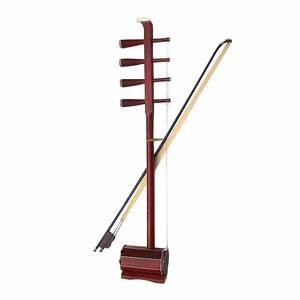Sihu overview
 Sihu (pinyin: sì hú) Mongolian called Huwuer, which originated from the ancient Xiqin. Mainly popular in Inner Mongolia, other places such as Shanxi, Shaanxi, Hebei, Henan and Sichuan are also popular.
Sihu (pinyin: sì hú) Mongolian called Huwuer, which originated from the ancient Xiqin. Mainly popular in Inner Mongolia, other places such as Shanxi, Shaanxi, Hebei, Henan and Sichuan are also popular.Sihu is often made of mahogany and red sandalwood. The barrel is mostly octagonal, covered with python skin or cowhide. The peg and the shaft hole have no taper. The tension of the string is used to compress the shaft hole to fix it, and some are still on the rod. , The drum is inlaid with luotian patterns for decoration, and the thin bamboo system uses the horsetail as the bow.
The fingering of Sihu is also very unique. It does not use fingertips to press strings like erhu and other stringed instruments, but uses the second rhythm of fingers to produce glissando, hitting, plucking, overtones, etc., so the sound is more beautiful, Mellow, melodious, more grassland style. It is most suitable for the accompaniment of Mongolian folk artist's rap "Hao Lai Bao" and Mongolian Qin Shu (Uliger). In their spare time, the herdsmen gathered in the yurts, and the entertainers pulled up the four hus and narrated the heroic epics and some moving stories in history in the form of rap. The rhythm of the piano drum complements the artist's rap and singing, which is fascinating.
In Goerros, where Mongolian national culture has a long history, Sihu, as a unique national musical instrument, has been passed down from generation to generation. In the old society, Sihu was a means used by folk artists to talk about the miserable life of herdsmen, the exploitation and oppression of the herdsmen, yearn for a better life, and sing praises of heroic epics.
- Chinese name:Sihu
- popular area:Inner Mongolia
- alias:Four strings, two clip strings
- pinyin:sì hú
overview of other similar instruments
- sanyanxiao overview
- Daguangxian overview
- Leiqin overview
- hahao overview
- yandundagu overview
- Han Xiaozheng overview
- Fang Xiang overview
- guanzi overview
- zhuqin (Dao Qin) overview
- zhuiqin overview
- bangzi overview
- three-stringed piano overview
- Gehu overview
- xiao overview
- xiaokonghou overview
- Konghou overview
- Sheng overview
- suona overview
- hulusi overview
- gushao overview
 渝公网安备 50010702504639号
渝公网安备 50010702504639号